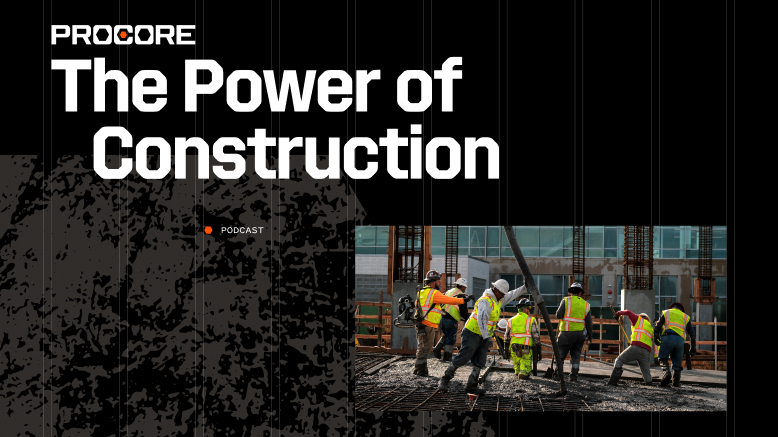— 9 min read
How To Improve Your Bid-Hit Ratio: 5 Strategies To Deploy


Last Updated Feb 20, 2025

Mason Finley
Strategic Industry Advisor, Preconstruction
Mason Finley is a Strategic Industry Advisor in Preconstruction at Procore Technologies in Austin, Texas. With over a decade of experience, he has advanced from Preconstruction Manager to Director at Ryan Companies US, Inc. Mason has also held key roles at Aspen Heights and SpawGlass, focusing on project management and preconstruction. In addition to his industry expertise, he has served in leadership roles at The Austin Stone Community Church, contributing to community development.

Kacie Goff
Contributing Writer
90 articles
Kacie Goff is a construction writer who grew up in a construction family — her dad owned a concrete company. Over the last decade, she’s blended that experience with her writing expertise to create content for the Construction Progress Coalition, Newsweek, CNET, and others. She founded and runs her own agency, Jot Content, from her home in Ventura, California.
Last Updated Feb 20, 2025

The bidding process is a necessary part of the construction game for any general or specialty contractor. Without bidding jobs and getting awarded contracts, the company doesn’t have a way to make money.
As the old saying goes, though, bidding is proof that you need to spend money to make money, particularly during preconstruction.
The time teams spend evaluating the bid package and developing a competitive bid comes at a literal cost — the wages and salaries add to the project’s indirect costs. As a result, firms want to maximize how many contracts they land per bid they submit. That means optimizing their bid-hit ratio. This guide outlines how to calculate this ratio, along with tips on how to improve your bid-hit ratio to maximize your company’s likelihood of winning projects.
Table of contents
Calculating a Bid-Hit Ratio
Put simply, the bid-hit ratio is the percentage of wins that the company gets versus times at bat. In other words, it’s the measure of how effective the firm is at winning contracts each time it receives and responds to an invitation to bid (ITB).
To calculate the bid-hit ratio, use the following formula:
Bid-hit ratio = Number of contracts awarded ÷ total number of bids
What constitutes a good bid-hit ratio?
Bid-hit ratios are somewhat subjective in that what one firm considers good another may consider lackluster. That said, generally speaking, firms that work on design-bid-build projects aim for a ratio of 1:3-1:5 , while design-build firms often aim for a ratio of 1:3 (or 33%).
Now that a rough target is clear, it’s time to explore how to improve your bid-hit ratio. Here are five strategies that can help.
1. Have a plan to win.
This means taking the time to understand how the company can differentiate itself in the market. In other words, firms can often improve their bid-hit ratio by taking a rifle approach versus a shotgun one, meaning they target specific projects at which they will likely be successful.
To develop a plan to win, teams should take time to decide what they’re best at as a company and which clients most benefit from those areas of expertise. From this, they should be able to identify key markets in which they will be most competitive. Then, they can focus time and effort on pursuing projects there. In those pursuits, looping in the right players — like experienced field managers and senior superintendents — helps to create informed bids that will play well in that market.
Deciding as a company where we can differentiate ourselves involves identifying what we are truly good at and determining who the clients are that we want to target as key clients. Additionally, we need to pinpoint the key markets where we can be competitive and focus our time and effort there.

Mason Finley
Strategic Industry Advisor, Preconstruction
Procore
2. Know the client.
As firms hone in on which projects they should pursue, they can further improve their bid-hit ratio by investing time and energy into understanding and building a relationship with the client they’re pursuing. Owners generally like working with known commodities because they’re often more predictable and reliable. Creating good relationships with clients will lead to more opportunities to compete.
Once the company receives an invitation to bid (or a request for proposal), they should be proactive in reaching out to the client to understand their values. Take steps to build trust by focusing on what’s most important to that specific owner.
That often means a focus on the bottom line, but clients may have other priorities, too. They may be looking for certainty of delivery — the ability to deliver on budget, schedule and quality standards or expectations. They may be looking for someone with expertise to align their project scope with their budget and, in doing so, provide cost control. They might emphasize derisking the project or be searching for a partner whom they can count on for future projects. They may even be looking for a firm with expertise in a specific area, like cold storage or fully automated warehouses.
That relationship-building effort helps to create a more competitive bid — and, consequently, improve the bid-hit ratio — in two specific ways:
- Indirect costs: Clients may not always make their expectations around general conditions and general requirements clear. What do they expect as far as trailers and dumpsters on the job site, for example? Building a relationship with that owner and understanding their priorities can illuminate those things.
- Direct costs: Again, knowing the client helps the firm to understand and manage the owner’s expectations. A good working relationship allows the firm to apply the maxim: “go low and clarify.” In other words, it lets them submit a bid that's as competitive as possible in alignment with the project documents while leveraging the relationship to call out areas the owner may not have considered — and that could potentially increase project costs. This way, the bid won’t be dismissed out of hand for coming in too high, but the firm can still demonstrate its expertise.
Even if the company doesn’t win that specific contract, building the relationship may benefit them in the future. Moving forward, they may get access to opportunities that are only available to contacts already in the owner’s rolodex (i.e. in selective or closed tendering).
3. Know the scope.
When trying to figure out how to improve your bid-hit ratio, direct some time and energy toward spending time with the project’s scope of work. Look for creative solutions to deliver on the client’s values. When exploring the scope, seek out opportunities to show the owner that you understand what they care about and how your firm can be the partner that delivers on their priorities.
That means:
- Proactively thinking about cost optimization (such as value engineering)
- Presenting schedule savings ideas
- Sharing enough to show where opportunities lie but not giving away all your ideas before the contract is secured
Don’t let being a good partner price you out of winning. Again, go low and clarify. Thread the needle by sticking to the base bid but showing the firm has thought through the projects and its unique requirements.
If there’s an item that isn’t included in the scope but will be required, for example, call it out to the owner. Ideally, they’ll add that line item as they level bids to truly understand project costs.
Here, the relationship you built is a big help. Aim to think like the owner, truly getting to know their scope and the priorities behind it.
As firms evaluate the scope against their capabilities, they may benefit from exploring opportunities to self-perform work — creating opportunities for greater control over labor costs, allowing for a better profit margin without pricing them out of the running.
4. Know the Competition
As best is possible, try to understand how other firms will be approaching a project proposal.
This is generally easier with direct costs. Here, relationships with specialty contractors in the area is an asset. When it makes sense, invite them to submit their number. Don’t solicit bids from trade partners that aren’t actually in contention for the project, but expand the net here. When you have the quotes from specialty contractors that were requested from your competition, you have important data to make informed decisions on competing. This gives you a valuable tool to wield as you figure out how to improve your bid-hit ratio.
Indirect costs from competitors are trickier to discern but not impossible. For starters, public bids make this information available. Looking for any public projects the competition has bid can illuminate indirect costs.
Additionally, firms benefit from asking for feedback from owners whether they win the contract or not. The owner may say, for example, that they didn’t get the project because they were 5% higher than the competition. As the firm collects those insights, they’re better able to create competitive bids.
Learning the competition is massively important as you figure out how to improve your bid-hit ratio because it also highlights opportunities where the bid is probably not worth the effort. When the firm can’t differentiate itself from the competition, submitting a bid may contribute to a lower bid-hit ratio.
5. Know the Market
There are two specific areas you should explore as you figure out how to improve your bid-hit ratio:
- Specialty contractor relationships: A general contractor’s success in winning contracts directly hinges on the trade partners they leverage. That means evaluating the market to identify the strongest specialty contractors (or those you align best), then building relationships. It also means keeping up relationships with multiple partners so the firm doesn’t become overly reliant on a single other company. Across the board, the firm should aim to build mutual respect with its trade partners in their mutual pursuit of being profitable.
- Market trends: Keep a finger on the pulse of things globally, nationally and in the specific markets in which the firm operates. Look for insights and advantages in the target markets.
These are a few targeted options to improve a bid-hit ratio, but firms can explore even more bidding strategies. The more contracts they can get awarded for each bidding effort, the higher the return on that investment.
Stay updated on what’s happening in construction.
Subscribe to Blueprint, Procore’s free construction newsletter, to get content from industry experts delivered straight to your inbox.

Crafting a Winning Bidding Strategy
Improving the bid-hit ratio requires a strategic and focused approach. It starts with crafting a clear plan to win by pinpointing areas where the company can truly differentiate itself in the market. Building solid relationships with clients is crucial, as it opens doors to new opportunities and ensures alignment with client values beyond just pricing concerns.
A deep understanding of project scopes — combined with effective cost strategies like "go low and clarify" — is vital for staying competitive. Additionally, exploring self-performance opportunities can offer a competitive advantage. It's important to have a thorough knowledge of the competition and carefully decide which bids to pursue based on the firm’s unique strengths, ensuring efforts are not squandered on unsuitable projects. Keeping a finger on the pulse of market trends and nurturing strong relationships with specialty contractors further boost competitiveness in ever-changing markets. By implementing these strategies, companies can enhance their bid-hit ratios and make more informed decisions in their bidding efforts.
Was this article helpful?
Thank you for your submission.
100%
0%
You voted that this article was . Was this a mistake? If so, change your vote
Scroll less, learn more about construction.
Subscribe to The Blueprint, Procore’s construction newsletter, to get content from industry experts delivered straight to your inbox.
By clicking this button, you agree to our Privacy Notice and Terms of Service.
Thank you!
You’re signed up to receive The Blueprint newsletter from Procore. You can unsubscribe at any time.
Categories:
Written by

Mason Finley
Strategic Industry Advisor, Preconstruction | Procore
Mason Finley is a Strategic Industry Advisor in Preconstruction at Procore Technologies in Austin, Texas. With over a decade of experience, he has advanced from Preconstruction Manager to Director at Ryan Companies US, Inc. Mason has also held key roles at Aspen Heights and SpawGlass, focusing on project management and preconstruction. In addition to his industry expertise, he has served in leadership roles at The Austin Stone Community Church, contributing to community development.
View profile
Kacie Goff
Contributing Writer | Procore Technologies
90 articles
Kacie Goff is a construction writer who grew up in a construction family — her dad owned a concrete company. Over the last decade, she’s blended that experience with her writing expertise to create content for the Construction Progress Coalition, Newsweek, CNET, and others. She founded and runs her own agency, Jot Content, from her home in Ventura, California.
View profileExplore more helpful resources

What Happens When Data Drives the Business?
Construction has long been seen as a low-margin industry. But what if the real problem isn’t the margins—it’s how decisions get made? In episode 17 of The Power of Construction,...

Vet Contractors with Confidence: A Guide to Smart Bidder Selection
Selecting the right bidder is one of the most consequential decisions a construction team makes — yet it often happens under tight deadlines, with limited visibility into the long-term implications....

The Construction Bid Interview & Follow-up: Closing the Deal
During construction project bidding, the interview is often the last part of the request for proposal (RFP) process and one of the most influential. For teams that advance to the...
Construction Business Development: Tracking and Winning the Right Opportunities
Construction business development isn’t just a response to deadlines: It’s a long-term strategy rooted in focus, visibility and timing. Delays, funding gaps and market pressure have made it harder to...
Free Tools
Calculators
Use our calculators to estimate the cost of construction materials for your next project.
Templates
Find a template to help you with your construction project tasks.
Material Price Tracker
Get the latest U.S. retail prices and view historical trends for common building materials.
Glossary
Explore key terms and phrases used in the industry.
